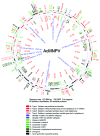Gene gymnastics: Synthetic biology for baculovirus expression vector system engineering
- PMID: 23328086
- PMCID: PMC3813527
- DOI: 10.4161/bioe.22966
Gene gymnastics: Synthetic biology for baculovirus expression vector system engineering
Abstract
Most essential activities in eukaryotic cells are catalyzed by large multiprotein assemblies containing up to ten or more interlocking subunits. The vast majority of these protein complexes are not easily accessible for high resolution studies aimed at unlocking their mechanisms, due to their low cellular abundance and high heterogeneity. Recombinant overproduction can resolve this bottleneck and baculovirus expression vector systems (BEVS) have emerged as particularly powerful tools for the provision of eukaryotic multiprotein complexes in high quality and quantity. Recently, synthetic biology approaches have begun to make their mark in improving existing BEVS reagents by de novo design of streamlined transfer plasmids and by engineering the baculovirus genome. Here we present OmniBac, comprising new custom designed reagents that further facilitate the integration of heterologous genes into the baculovirus genome for multiprotein expression. Based on comparative genome analysis and data mining, we herein present a blueprint to custom design and engineer the entire baculovirus genome for optimized production properties using a bottom-up synthetic biology approach.
Keywords: BEVS; MultiBac; OmniBac; baculovirus; comparative genome analysis; multiprotein complexes; recombinant protein production.
Figures


Similar articles
-
New baculovirus expression tools for recombinant protein complex production.J Struct Biol. 2010 Oct;172(1):45-54. doi: 10.1016/j.jsb.2010.02.010. Epub 2010 Feb 21. J Struct Biol. 2010. PMID: 20178849
-
OmniBac: universal multigene transfer plasmids for baculovirus expression vector systems.Methods Mol Biol. 2014;1091:123-30. doi: 10.1007/978-1-62703-691-7_7. Methods Mol Biol. 2014. PMID: 24203327
-
MultiBac: expanding the research toolbox for multiprotein complexes.Trends Biochem Sci. 2012 Feb;37(2):49-57. doi: 10.1016/j.tibs.2011.10.005. Epub 2011 Dec 7. Trends Biochem Sci. 2012. PMID: 22154230 Free PMC article. Review.
-
A Comprehensive Guide to the Commercial Baculovirus Expression Vector Systems for Recombinant Protein Production.Protein Pept Lett. 2020;27(6):529-537. doi: 10.2174/0929866526666191112152646. Protein Pept Lett. 2020. PMID: 31721691 Review.
-
Baculovirus expression: old dog, new tricks.Bioengineered. 2015;6(6):316-22. doi: 10.1080/21655979.2015.1104433. Bioengineered. 2015. PMID: 26488462 Free PMC article.
Cited by
-
BIN1 reduction ameliorates DNM2-related Charcot-Marie-Tooth neuropathy.Proc Natl Acad Sci U S A. 2025 Mar 11;122(10):e2419244122. doi: 10.1073/pnas.2419244122. Epub 2025 Mar 5. Proc Natl Acad Sci U S A. 2025. PMID: 40042903
-
Combining dynamin 2 myopathy and neuropathy mutations rescues both phenotypes.Nat Commun. 2025 May 20;16(1):4667. doi: 10.1038/s41467-025-59925-6. Nat Commun. 2025. PMID: 40393994 Free PMC article.
-
Comprehensive identification of protein orthologs in the family Ascoviridae facilitates an understanding of phylogenomics, protein conservation, and phosphorylation.Arch Virol. 2022 Apr;167(4):1075-1087. doi: 10.1007/s00705-022-05402-0. Epub 2022 Mar 5. Arch Virol. 2022. PMID: 35246734
-
Synthetic Virus-Derived Nanosystems (SVNs) for Delivery and Precision Docking of Large Multifunctional DNA Circuitry in Mammalian Cells.Pharmaceutics. 2020 Aug 11;12(8):759. doi: 10.3390/pharmaceutics12080759. Pharmaceutics. 2020. PMID: 32796680 Free PMC article. Review.
-
Improvement of protein production in baculovirus expression vector system by removing a total of 10 kb of nonessential fragments from Autographa californica multiple nucleopolyhedrovirus genome.Front Microbiol. 2023 Apr 13;14:1171500. doi: 10.3389/fmicb.2023.1171500. eCollection 2023. Front Microbiol. 2023. PMID: 37125202 Free PMC article.
References
Publication types
MeSH terms
Substances
LinkOut - more resources
Full Text Sources
Other Literature Sources
